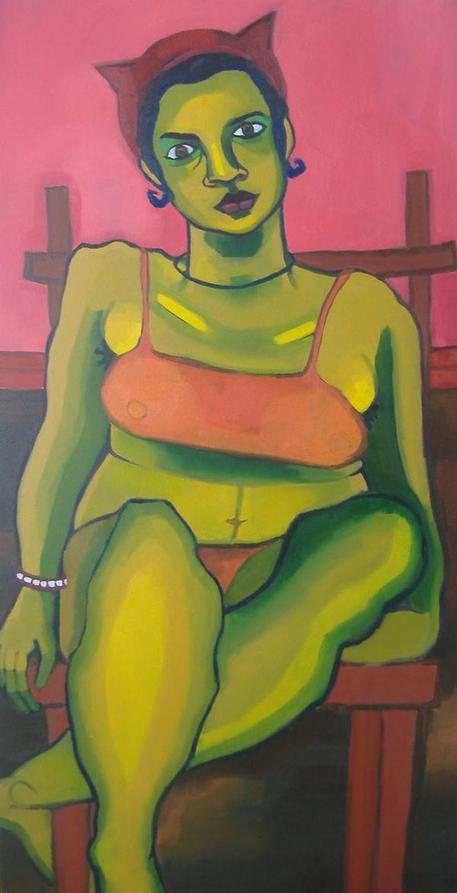That's Mr. Baby to you : Sherry Garcia
Gamma Ray Productions

Image copyright Sherry Garcia, 2000, courtesy Sherry Garcia, myspace
Sherry Garcia's vivid pictures are about people. Much could be made about who the people apparently are. I was hoping not to get into this issue. I don't believe it's the point of what she's trying to do, however, some aspects of this deserve attention.
Apparently the people in the pictures are ...uh lesbians. I feel uncomfortable already since this statement can so easily devolve into some ridiculously obvious statement. But people continue to discriminate and given how often lesbophobia rears its ugly head... maybe it does need to be said—lesbians are people too.
No, the dilemma is that drawing conclusions about the people in Garcia's paintings involves buying into the mythology that lesbians can be visually identified.
As a woman of colour, I must admit, I have difficulty with this.
Do they all have brown eyes? The same shade of skin? Unique body parts? Do all lesbians wear the same clothing? Historically this very issue of visibility has demarcated the differences in experiencing racism, sexism and homophobia. Women and people of colour can't change the basis of their visual difference—we are eternally attached to it.
So let me just say that probably most of the women in Sherry Garcia's paintings are lesbians. Along with my observations, it's what I concluded by the context, the pictures and a brief chat with Garcia.
And besides, aside from herself, all the "models" are imaginary composites of pictures from magazines or photographs.
Right. Now that's out of the way.... Essentially Garcia's paintings are striking portraits of ordinary women in all their varied shapes, colours and sizes. Here Garcia's triumph lies in that sexual preference is a specificity that's not erased but is as important or not as the occasional tattoo, piercing, y-fronts or other details.
Predominantly using rich, darker shades of purples, blues and greens, sprinkled with bright pinks and reds, Garcia treats us to some scenes from daily life—trips to the bathroom, snuggling on a sofa, for instance.
"I'm not drawn to big scenes of people," says 24-year-old Garcia. The maximum number of women in one painting is two, usually a couple.
Filling out her first grant application or gallery proposal, Garcia forgets which, she needed titles for her work, something she found odd. "It was funny that they wanted something I'd put on afterwards," says the Ottawa School of Art alumnus. For inspiration, she looked to music listened to while painting, making titling part of the process itself.
"Keep it like a secret", 1999. A painting dominated by green, turquoise and purple, the woman in her bathtub has dark circles under her eyes. In another context, this could be construed as imaginative make-up, but here, given how many of the women's eyes are like this, it looks like fatigue, a vague unease. But women who are sick and tired of what? Given the irony and sometimes deadpan humour in the titles, there can be so many answers. It seems the scenes are interiors not only in the physical sense but psychologically too.
Published in The Ottawa Xpress, 2000
Apparently the people in the pictures are ...uh lesbians. I feel uncomfortable already since this statement can so easily devolve into some ridiculously obvious statement. But people continue to discriminate and given how often lesbophobia rears its ugly head... maybe it does need to be said—lesbians are people too.
No, the dilemma is that drawing conclusions about the people in Garcia's paintings involves buying into the mythology that lesbians can be visually identified.
As a woman of colour, I must admit, I have difficulty with this.
Do they all have brown eyes? The same shade of skin? Unique body parts? Do all lesbians wear the same clothing? Historically this very issue of visibility has demarcated the differences in experiencing racism, sexism and homophobia. Women and people of colour can't change the basis of their visual difference—we are eternally attached to it.
So let me just say that probably most of the women in Sherry Garcia's paintings are lesbians. Along with my observations, it's what I concluded by the context, the pictures and a brief chat with Garcia.
And besides, aside from herself, all the "models" are imaginary composites of pictures from magazines or photographs.
Right. Now that's out of the way.... Essentially Garcia's paintings are striking portraits of ordinary women in all their varied shapes, colours and sizes. Here Garcia's triumph lies in that sexual preference is a specificity that's not erased but is as important or not as the occasional tattoo, piercing, y-fronts or other details.
Predominantly using rich, darker shades of purples, blues and greens, sprinkled with bright pinks and reds, Garcia treats us to some scenes from daily life—trips to the bathroom, snuggling on a sofa, for instance.
"I'm not drawn to big scenes of people," says 24-year-old Garcia. The maximum number of women in one painting is two, usually a couple.
Filling out her first grant application or gallery proposal, Garcia forgets which, she needed titles for her work, something she found odd. "It was funny that they wanted something I'd put on afterwards," says the Ottawa School of Art alumnus. For inspiration, she looked to music listened to while painting, making titling part of the process itself.
"Keep it like a secret", 1999. A painting dominated by green, turquoise and purple, the woman in her bathtub has dark circles under her eyes. In another context, this could be construed as imaginative make-up, but here, given how many of the women's eyes are like this, it looks like fatigue, a vague unease. But women who are sick and tired of what? Given the irony and sometimes deadpan humour in the titles, there can be so many answers. It seems the scenes are interiors not only in the physical sense but psychologically too.
Published in The Ottawa Xpress, 2000

